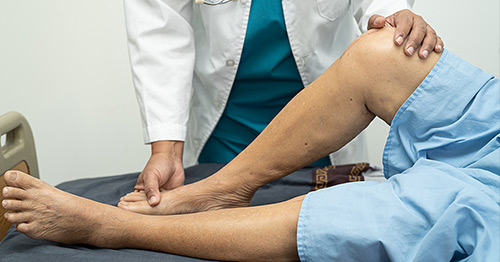What Is a Physiatrist?
An Integral Part of Non-Operative Care
It’s not always easy to find the right kind of doctor when you have body pain or an injury. Will simple rest or exercise can fix the problem or is it a serious condition that may require orthopedic surgery? All medical and surgical departments at HSS share the goal: for each patient to see the right practitioner for the right treatment at the right time. There is a full range of medical specialists who diagnose and treat pain without surgery, or who will refer you to a surgeon if needed. These include pain management doctors, sports medicine physicians, physical therapists and physiatrists.
What is a physiatrist?
Physiatrists − or rehabilitation medicine physicians − are doctors with specialized training in the evaluation, diagnosis and nonsurgical treatment nerve, muscle, bone and joint conditions that affect how you move, from sore shoulders to spinal cord injuries. This includes of spine, sports, neurological and musculoskeletal injuries and diseases, pain syndromes, disabilities and impairments.
A physiatrist treats the whole person − not just the problem areas – but provides nonsurgical treatments and some interventional procedures to restore maximum function and flexibility to the affected parts of the body. At HSS, each physiatrist specializes even further to conditions and injuries that affect a particular area of the body, such as the hip, knee, spine, foot, ankle, shoulder, hand and wrist.
What exactly does a physiatrist do?
Physiatrists specialize in physical medicine and rehabilitation (PM&R), and they diagnose and direct nonsurgical treatment for people with pain and/or temporary debility from an injury, disorder disease or other condition. They also perform interventional treatment procedures such as epidural steroid injections.
Physiatrists focus on a personalized method of treatment to improve their patients' quality of life − one that involves a comprehensive approach to expand the framework of resources at a patient's disposal. As a result, a patient's recuperation involves every aspect of their lives. By providing an appropriate treatment plan, these rehabilitation physicians help patients stay as active as possible at any age.
A physiatrist:
- Diagnoses and treats pain.
- Restores maximum function lost through injury, illness or disabling conditions.
- Treats the whole person, not just the problem area.
- Leads a team of medical professionals.
- Provides nonsurgical treatments.
- Explains your medical problems and treatment/prevention plan.
How do physiatrists diagnose pain and conditions?
Physiatrists diagnose issues by performing thorough patient histories, physical exams and, if needed, radiological imaging (X-rays, ultrasounds, MRIs). For some situations, they may also perform electrodiagnostic testing to measure the condition of a person’s nerves and muscles both in their relaxed and stimulated states. These tests may include nerve conduction studies or electromyography (EMG).
What conditions do physiatrists treat?
Physiatrists treat common problems such as pain in the neck, shoulder, low back, hips and knees to more serious issues such as spinal cord injuries and neurological disorders. This includes nerve entrapment conditions like carpal tunnel syndrome, cubital tunnel syndrome, radiculopathy and sciatica.
Generally, physiatrists treat a wide variety of problems that can include stroke or burn victims, but HSS physiatrists are specifically trained and certified to help people with musculoskeletal, spine and sports injuries.
What is a physiatrist's role in treatment?
Physiatrists accurately pinpoint the source of an ailment and design a comprehensive, nonsurgical treatment plan to be carried out by the patients themselves or in coordination with a team of specialists that may include physical or occupational therapists, rehabilitation nurses, psychologists, social workers, recreational therapists, neurologists or other clinicians.
At HSS, physiatrists also perform several kinds of minimally invasive procedures in combination with medically supervised exercise therapies, medications and/or orthotics to restore mobility and function without the need for surgery. Such procedures may include:
- corticosteroid injections, including epidural steroid injections
- minimally invasive intradiscal electrothermoplasty (IDET)
- nucleoplasty
- radiofrequency ablation
- fluoroscopic injection procedures
- arthroscopic shoulder and knee lavage
In addition, several HSS physiatrists have special multidisciplinary areas of specialization, such as osteoporosis or hip preservation (treating hip osteoarthritis without joint replacement surgery).
What kind of training do physiatrists require?
Physiatrists train for four years in medical school, followed by a one-year internship and three years of hospital residency with a specialization in physiatry. The board certified physiatrists at HSS have also received advanced degrees and fellowships in several areas of musculoskeletal specialization.
HSS integrates physician care and clinical research
At HSS, collaboration between physiatry and other orthopedic specialties is often facilitated by the presence of physiatrists in the physical settings in which patients receive care.
For example, a patient seeing a spine surgeon can often consult a physiatrist in the same office suite, if nonsurgical care is recommended. Likewise, if a physiatrist determines a patient may benefit from surgery, a referral to an appropriate surgeon at the same location can usually be made. This arrangement allows for an easy transition for patients and improved communication among physicians.
In addition to acting as partners with other specialists in the delivery of care, HSS physiatrists take an active role in collaborative research, such as conducting surveys to clearly identify patient expectations and goals of care. Areas of study include regenerative medicine, a discipline in which platelet-rich plasma, bone morphogenic proteins and/or stem cells may be used to repair and restore damaged and diseased musculoskeletal tissue.
It’s important for research teams to include members of multiple departments. Bringing together different points of view helps us get a better understanding of what the research shows and which patients may potentially benefit from it.
Posted: 5/23/2018
Authors
Physiatrist-in-Chief, Hospital for Special Surgery
Attending Physiatrist, Hospital for Special Surgery



